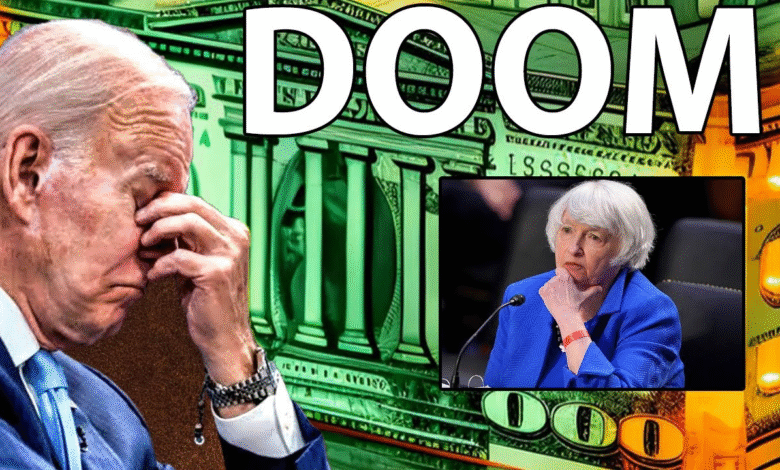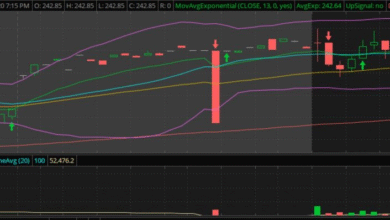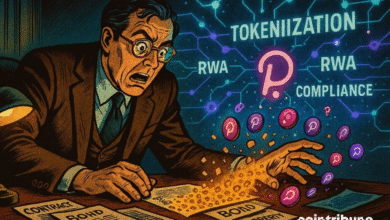U.S. Debt Explosion: Ray Dalio Warns of Economic Turmoil

The U.S. debt explosion has reached alarming levels, with experts like Ray Dalio predicting severe financial market disruptions in the near future. As government spending continues unabated alongside stagnant revenues, the national debt crisis looms larger than ever, raising urgent questions about fiscal responsibility. Dalio foresees annual expenditures ballooning to $7 trillion, while revenues struggle at around $5 trillion, pushing the national debt from 100% to a staggering 130% of GDP over the next decade. This trajectory signifies a potential shift in the economic landscape, resulting in costly interest rate hikes and inevitable government spending cuts. With each American family facing an increasing share of the debt burden, the stakes have never been higher as we navigate these turbulent fiscal waters.
Amid escalating national liabilities, the financial turmoil around America’s soaring debt poses significant challenges for the economy. Thought leaders like Ray Dalio have voiced concerns about the impending repercussions of unprecedented fiscal imbalance and rising interest obligations. As policymakers grapple with the implications of unchecked government outlays, the landscape hints at an impending national debt crisis that could provoke widespread financial instability. The dire predictions reflect a need for urgent remedial measures, such as strategic government spending cuts and thoughtful tax reforms, to avert painful economic shocks. With the potential for drastic market shifts on the horizon, understanding these dynamics is crucial for navigating the complexities of our fiscal future.
Ray Dalio on U.S. Debt Explosion and Its Consequences
Ray Dalio’s warnings regarding the impending U.S. debt explosion are raising alarms across financial markets and policy-making platforms. With government debt surging to unprecedented levels, Dalio highlights the critical danger that this poses not only to the economy but also to individual American families. The escalating national debt risks surpassing a staggering $18 trillion, creating conditions ripe for financial market disruptions. As Dalio predicts, the burden of this debt will likely end up costing each family significantly more, threatening their financial stability and economic prospects.
The trajectory of U.S. debt accumulation is underscored by alarming forecasts that suggest the country’s liabilities could overshadow GDP growth in the coming decade. Dalio’s analysis warns that the government’s tendency to continually increase spending without corresponding revenue gains will lead to a national debt crisis. The impact of this crisis would entail painful economic adjustments, including potential tax hikes and cuts in essential government services as policymakers struggle to manage the ballooning debt.
Predictions of Financial Market Disruptions Due to Rising Debt
As the national debt soars, Dalio asserts that financial markets are on the brink of experiencing severe disruptions. He points out that as debt servicing costs climb—increased payments for both interest and principal—investors will likely feel the strain on economic growth. This might trigger volatility in stock markets and possibly culminate in larger financial crises if not addressed swiftly. By connecting government spending cuts and interest rate hikes to these predictions, Dalio makes a compelling case that the burden of repayment will reverberate throughout the economy.
Furthermore, Dalio’s predictions suggest that investors should brace themselves for a market environment characterized by uncertainty and potential upheaval. These financial market disruptions may manifest as a result of overly aggressive monetary policies or unexpected shifts in fiscal strategies. If the government fails to implement necessary reforms to mitigate the effects of rising debt, Dalio warns that we could witness a cascade of economic challenges, from inflation spikes to market crashes.
The Implications of National Debt Crisis on American Families
The looming national debt crisis poses significant implications for average American families, with projections estimating that total family debt will considerably increase as governmental debts grow. Ray Dalio’s figures suggest that debt per household could rise to approximately $425,000 if trends continue unchecked. This profound increase in financial obligations could diminish disposable incomes, complicating financial planning and stressing family budgets.
Moreover, as the government faces the pressure to address its fiscal imbalance, American families may be forced to confront the reality of reduced public services and potential tax hikes. The consequences of insufficient governmental action could lead to a decline in quality of life, as essentials and social services become vulnerable to funding cuts. In this environment, the predictions from economists like Dalio become not just abstract numbers but a tangible reality faced by families across the country.
Government Spending Cuts and the Path to Fiscal Stability
Addressing the U.S. debt crisis through government spending cuts is a strategy often discussed by financial experts, and Ray Dalio urges that such measures are essential. With the anticipated increase in deficits, government leaders will have to reevaluate their fiscal policies, prioritizing reforms that can curtail unnecessary expenditures without severely affecting critical programs. The challenge lies in formulating a balanced approach that meets the immediate needs of the economy while ensuring long-term sustainability.
Dalio’s warnings about the necessity of spending cuts suggest a bleak outlook if decisive action is not taken swiftly. Without addressing the inherent fiscal imbalance, the country risks falling into a cycle of debt that could become increasingly difficult to manage. As the public perceives the reality of the national debt crisis, they may demand accountability and transparency from their leaders, pushing for reforms aimed at curbing expenditures and ensuring fiscal responsibility.
Interest Rate Hikes: A Necessary Evil?
In light of the mounting national debt, discussions around interest rate hikes have gained prominence in economic circles. Ray Dalio emphasizes that this strategy might, paradoxically, be necessary to combat the negative implications of excessive borrowing. Hikes could help stabilize the financial system in the long run, encouraging greater fiscal discipline and reducing the likelihood of sustained market disruptions.
However, interest rate hikes also carry consequences that may adversely affect consumers and borrowers. Increased rates lead to higher costs of borrowing, impacting everything from mortgages to business loans. As families face greater financial strain, the very measures intended to secure economic stability could lead to reduced consumer spending, posing further challenges to economic recovery and growth.
Future Outlook: Mitigating the Risk of Economic Turmoil
The future of the U.S. economy hinges on how swiftly and effectively policymakers can respond to Ray Dalio’s warnings about rising debt and potential disruptions. To mitigate the risk of economic turmoil, immediate action must be taken to create a sustainable fiscal policy, addressing the root causes of the national debt crisis while incorporating strategies to enhance revenue without alienating taxpayers.
A mixture of prudent government spending cuts, sensible tax reforms, and initiatives aimed at boosting economic productivity could present a viable path forward. If implemented correctly, these measures might instill confidence in financial markets and investors, allowing for a more stable economic environment. However, without a comprehensive response to the threats posed by the increasing debt, the potential for painful disruptions remains ever-present.
The Role of Policymakers in Addressing Fiscal Imbalance
Policymakers play a critical role when addressing the issues raised by Ray Dalio regarding fiscal imbalance. They face challenges in prioritizing decisions that can stave off economic disaster while also meeting the needs of their constituents. Effective governance may require tough decisions that balance the need for spending on social programs with the necessity of reducing the national debt.
To navigate these challenges, policymakers must advocate for transparency in financial reporting, ensuring that citizens are informed about the implications of national debt. By promoting public understanding of these issues, they can facilitate a more informed dialogue among constituents, which could help garner the support needed for necessary reforms aimed at achieving fiscal stability.
Economic Growth vs. Debt: Finding the Right Balance
The delicate balance between economic growth and public debt is at the forefront of debates surrounding fiscal policy. Ray Dalio points to the dangers posed by excessive government borrowing if not countered by sufficient growth metrics. For the U.S. economy to thrive, it must foster conditions that encourage innovation, job creation, and sustainable growth while simultaneously managing its debt levels.
A successful strategy would involve investments in key sectors that can drive economic expansion without exacerbating the debt crisis. This means policymakers should prioritize areas such as infrastructure development, education, and technology—each critical for boosting productivity and fostering long-term economic health. The challenge lies in making these investments while keeping an eye on the economic realities dictated by growing national debt.
Engaging Citizens in the Conversation on National Debt
In the face of such dire predictions from financial experts like Ray Dalio, engaging citizens in conversations about national debt is more essential than ever. Empowering the public with understanding of the significance of fiscal policy can create a demand for accountability and responsible governance. Strategies for public engagement include transparent discussions about budget allocations and their direct impacts on everyday citizens, thereby fostering an informed electorate.
Encouraging civic involvement Not only elevates public discourse but also compels policymakers to consider the broader implications of their actions on the economy. When citizens are equipped with knowledge about fiscal issues, pressures mount for spending reforms and better financial decisions that align with the needs of the population, thus contributing to a more balanced approach to managing the national debt.
Frequently Asked Questions
What does Ray Dalio’s prediction of a U.S. debt explosion mean for the economy?
Ray Dalio warns that a U.S. debt explosion could lead to significant financial market disruptions. With national debt projected to jump to $18 trillion in servicing costs, the economy may face painful shocks if government spending cuts and policy adjustments are not implemented.
How will the U.S. debt explosion affect government spending and services?
The U.S. debt explosion could result in necessary government spending cuts as rising interest payments strain the budget. Without adjustments, the national debt crisis may force policymakers to decide between cutting programs or increasing taxes.
What role do interest rate hikes play in the U.S. debt explosion?
Interest rate hikes are critical in the context of the U.S. debt explosion. As debt servicing costs rise significantly, higher interest rates could compound existing fiscal pressures, further exacerbating the national debt crisis.
What are the potential consequences of the U.S. debt explosion according to Ray Dalio?
Ray Dalio suggests that without corrective measures, the U.S. debt explosion could lead to severe economic disruptions, including reduced fiscal stability, increased taxes, and possible monetary expansions that would erode purchasing power.
How does Ray Dalio’s view on the U.S. debt explosion highlight the risks for American families?
Dalio indicates that as the U.S. debt approaches 130% of GDP, each American family’s debt burden could rise to $425,000, highlighting the risks and long-term implications of the U.S. debt explosion on household finances.
What can be done to prevent a U.S. debt explosion from leading to a national debt crisis?
Preventing a U.S. debt explosion from escalating into a national debt crisis requires a multifaceted approach, including government spending cuts, increased revenue through taxes, and strategic interest rate adjustments to stabilize the economy.
What does the U.S. Congressional Budget Office say about the future of U.S. debt levels?
The U.S. Congressional Budget Office predicts that significant fiscal measures will contribute an additional $3.3 trillion to the national debt by 2034, intensifying concerns over the looming U.S. debt explosion.
What historical trends does Ray Dalio refer to when discussing the U.S. debt explosion?
Ray Dalio refers to historical trends where policymakers have traditionally opted to lower interest rates and devalue currency to manage unsustainable debt levels, a practice he believes obscures true economic health.
Why does Ray Dalio emphasize the need for immediate action against the U.S. debt explosion?
Dalio emphasizes the urgent need for action against the U.S. debt explosion to avoid yielding to severe and painful economic disruptions that could threaten financial stability and societal cohesion.
| Key Point | Details |
|---|---|
| Ray Dalio’s Warning | The U.S. is facing an $18 trillion debt explosion with painful disruptions expected. |
| Debt to GDP Ratio | Forecasted increase from 100% to 130% over the next decade. |
| Annual Expenditure vs Revenue | Expenditure: $7 trillion, Revenue: $5 trillion, deepening fiscal imbalance. |
| Debt Burden Per Family | Projected increase from $230,000 to $425,000 per family over the next decade. |
| Servicing Costs | Costs will rise from $10 trillion to about $18 trillion, including significant interest payments. |
| Potential Solutions | Possible government action includes program cuts, tax hikes, or monetary expansion. |
| Congressional Budget Office Prediction | Debt may increase by an additional $3.3 trillion as a result of new fiscal policies. |
| Historical Trend | Policymakers often lower interest rates and devalue currency instead of addressing debt levels directly. |
| Urgency for Change | Immediate adjustments needed in spending, taxes, and interest rates to avoid turmoil. |
Summary
The U.S. Debt Explosion is reaching critical levels, with Ray Dalio emphasizing the need for urgent reforms to avert severe financial disruptions. As the national debt surges to $18 trillion, the implications for economic stability are concerning. Without strategic adjustments in government spending and revenue generation, the nation faces a significant risk of systemic instability that could affect millions. The urgency for fiscal responsibility has never been more evident, and proactive measures are essential to protect the future of the economy.



